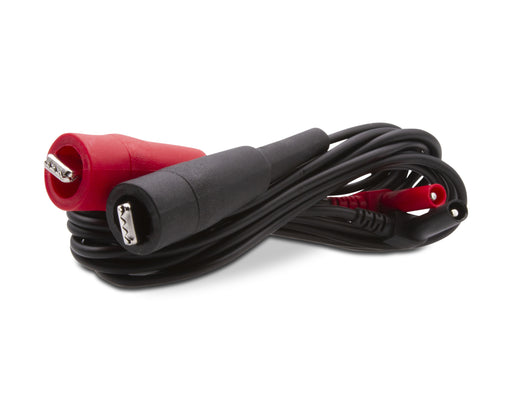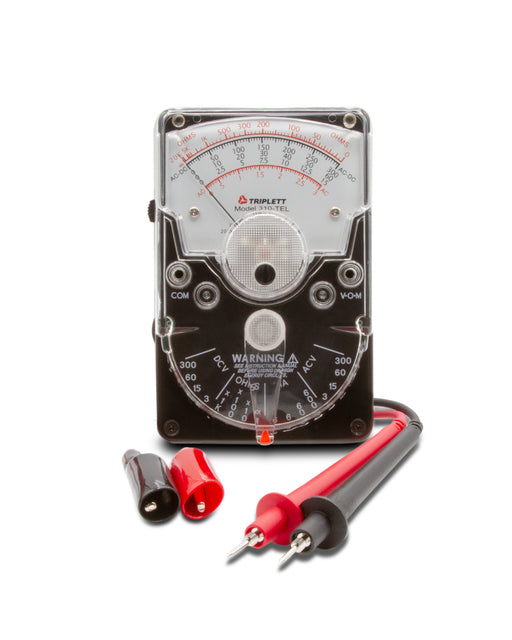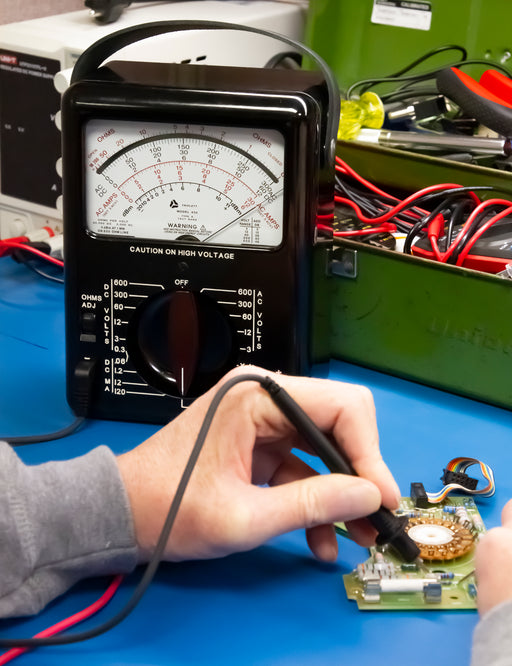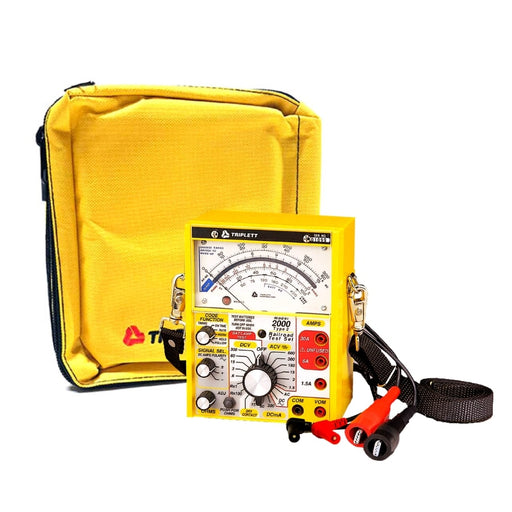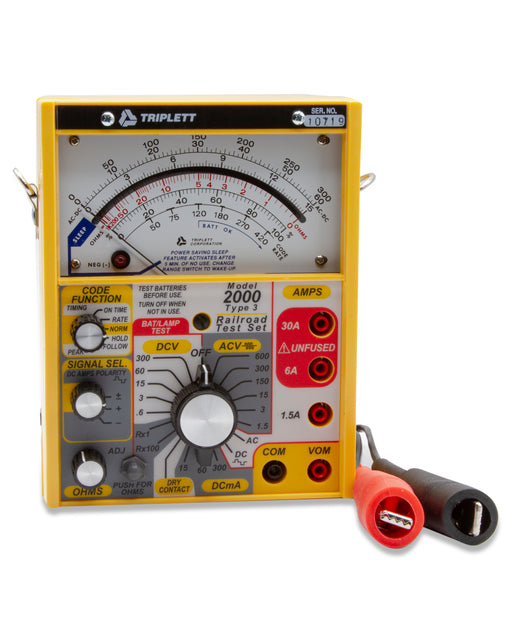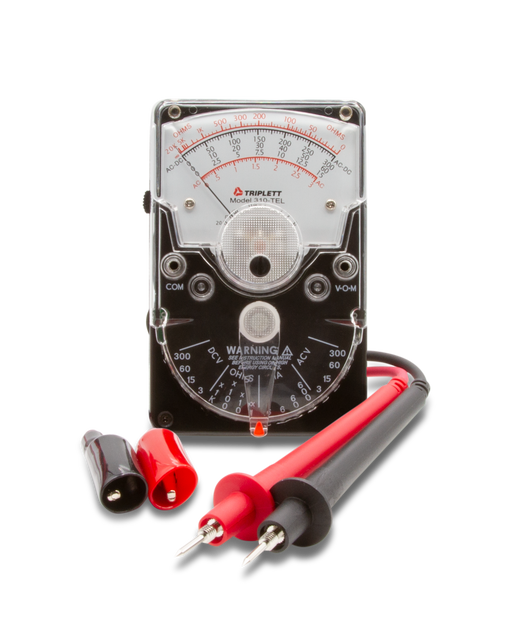Know More About Triplett Analog VOM Meters
What is an AC and DC analog voltmeter?
The DC and AC analog voltmeter is that AC voltmeter that measures the root mean square (RMS) value of the voltage (AC). Against this, the DC voltmeter measures the peak DC voltage. Another key difference lies in its working principle.
- The AC analog voltmeter utilizes a rectifier for signal amplification. The signal thus amplified is converted into DC and is made to pass through the meter comprising a moving coil magnet. This signal varies the pointer indication and then measures the RMS value of voltage – AC.
- The DC analog voltmeter chooses a particular voltage and then attenuates it entirely. It amplifies only the selected voltage and makes it pass through the PMMC meter. It does not use a rectifier for amplifying the signal.
How do you use an analog voltage meter?
Follow the below-given steps to use analog volt meter.
- Take the set of leads or wires in hand. The set comprises red and black wires.
- Connect the black wire to the negative side of the terminal and red to the positive side.
- You can measure continuity using a wire; measure resistance using a resistor; measure AC current and voltage using an AC socket, and measure DC current and voltage using an AA battery.
- Connect DUT and analog voltmeter using the test probes. Check the corresponding reading in the scale.
- Ensure the pointer moves across the scale as per the range chosen.
- Follow the same technique to measure different parameters.
How do you read an analog meter?
You can read an analog VOM meter using the following steps.
- Understand the usage of scales on the analog VOM meter. Typically such devices comprise three scales – O scale for resistance reading, AC scale for reading AC voltage, DC scale for reading DC voltage, and so on. There is also a dB scale involved, which is the least used.
- Set the dial for a value higher than the DUT. For instance, if you are testing a 240 VAC water heater, then set the dial to 300 AC. Similarly, set the meter to 150 V if you are testing a regular 120 V outlet.
- Understand the values between the numbers. The analog VOM meters follow the same scale as ordinary rulers. The lines between scales represent the same divisions as on a ruler. If you observe three lines between 50" and 70", perhaps, they may represent 55", 60", and 65".
- Check the settings of the dial and multiply it with the set values. For instance, if the multimeter is set to Rx100 and the needle on measurement points to 50 ohms. Then the value will be calculated as 50 x100=5000 and this will be the actual resistance of this circuit.
What are the applications of an analog VOM (volt-ohm-milliammeter)?
An analog VOM (volt-ohm-milliammeter) is a versatile measurement tool with a range of applications in electronics, electrical, and automotive fields. Some common applications include:
- Voltage Measurement:Analog VOMs are used to measure AC and DC voltage levels. This is essential for diagnosing electrical circuits, testing batteries, and ensuring proper voltage in various electronic devices.
- Resistance Measurement: Analog multimeters measure resistance in ohms, making them useful for testing the continuity of wires, assessing the health of resistors, and identifying open or short circuits.
- Current Measurement: Analog VOMs can measure current in both AC and DC circuits. This capability is crucial for checking the flow of current through components, such as fuses, and ensuring that circuits are properly functioning.
- Diode Testing: Some analog multimeters feature a diode testing function, allowing users to check the health and polarity of diodes and other semiconductor components.
- Continuity Testing: Continuity checks help identify open or disconnected circuits. When the multimeter probes touch, a tone or visual signal indicates the presence of a complete circuit.
- Battery Testing: Analog VOMs are often used to test the voltage of batteries, ensuring they have sufficient power.
- Electrical Troubleshooting: Electricians and technicians use analog multimeters for diagnosing electrical problems in household wiring, appliances, and industrial equipment.
- Automotive Repairs: Analog VOMs are valuable for testing automotive electrical systems, including batteries, alternators, and sensors.
- Basic Electronics: Analog VOMs are excellent tools for hobbyists and students learning about electronics. They can be used to build circuits, test components, and understand the fundamentals of electricity.
- Quality Control: Analog multimeters are sometimes used in quality control processes to check the electrical characteristics of components and products.
- Field Service: Analog VOMs are portable and suitable for field service work, allowing technicians to troubleshoot electrical issues on-site.
What is the function of analog tester?
An analog tester, also known as an analog multimeter or VOM (volt-ohm-milliammeter), is a versatile electronic instrument used for measuring various electrical quantities in a circuits such as current, voltage, resistance, signal power, and frequency. These devices are widely used to identify and rectify problems in electrical circuits.
Can AC voltmeter measure DC?
Yes, AC voltmeter can be used to measure DC. Electrodynamo meter and moving iron type instruments are generally used for measuring the current. Both these instruments offer the RMS value of AC, which equals to the corresponding DC. If a DC current source is connected to the AC voltmeter, then it would give the appropriate reading.
What is the voltage range of analog DC voltmeter?
Analog DC voltmeters are generally available in three ranges - 0-250V, 0-50V, and 0-10V. A user must understand the right display scale before taking the measurements. For instance, if the pointer reads 3V on the 0-10V scale, which is configured for measuring 0-1000V then this reading must be interpreted as 300V.
What is the difference between analog and digital multimeter?
Both these multimeters measure the changes in voltage; however, the method is different. Also, while digital meters have a display screen to see the values, analog meters have a dial and a pointer. To measure the voltage, analog meters use moving-coil galvanometers which have a suspended coil in a magnetic field. Analog meters are cheaper than digital multimeters because, they do require power supply aide from test source unlike their digital counterparts. While analog meters are durable, the conventional ones may cause confusion in readings. Hence, it is advisable to opt for analog meters with a certain level of accuracy and clarity in readings. Triplett offers analog meters with added features such as AC/DC voltage measurement in a wide range and the scales are clearly defined which increases the accuracy of readings.
How do you measure voltage with an analog multimeter?
Voltage is basically the potential difference between the given two points in a circuit. Here are the steps to measure voltage using an analog multimeter.
- Preset the analog meter to the required voltage range based on the application or battery type. This is because the analog meters we offer can measure AC and DC voltages in a huge range.
- Connect the probes of the meter to the points where the voltage needs to be measured.
- Connect the red probe to positive and the black one to the negative terminal.
- The display will show the values.
- In case of overload increase the range of the voltage.
- Make other adjustments in the device if required.
Is analog multimeter accurate?
While analog meters are perceived to be less accurate compared to digital meters, their accuracy levels can be increased owing to the additional features such as AC/DC voltage measurement up to 1200V, 18 or more such different ranges, fused resistance ranges, and so on. With all these features and more, our handy and portable models of analog meters are as accurate as bench-size ones or digital ones. Most of these models offer accuracy and precision as they have 20,000 ohms per volts DC sensitivity and 5,000 ohms per volt AC and beyond.
Can you test continuity with an analog multimeter?
Yes, most of our analog meters can measure continuity as they can measure resistance. These multimeters have an Ohm symbol on them. To get these settings right, you need to set the probes in contact with each other and turn the dial such that the pointer tilts towards the extreme right.
What are the parts of analog multimeter?
Generally, most analog meters comprise scale, pointer, zero-ohm adjustment knob, adjustment screw, ports, testing probes, and range selector knob. Our analog multimeters also come with test leads, alligator clips, a 12V A23, and 1.5V size N batteries.
When should an analog voltmeter be used?
If a circuit or a particular power carrying line shows a drop in power level or voltage, an analog meter can measure the same. This applies for batteries as well.
What is the working principle of analog meter?
The analog tester or voltmeter works on the principle of Ohm’s Law, which highlights the relationship between different electrical parameters. One equation states P=IE, where P stands for power, I for current, and E for voltage. This equation can be easily understood in terms of voltage, resistance, and current. The current is a result of voltage divided by resistance, or resistance is the result of voltage x current.
In an analog tester or voltmeter, the current is passed through a moving coil that lies between two magnets. This moving coil moves along with a permanent magnet on the application of voltage. The voltmeter is connected to the device under test (DUT). The resistor of known value is connected in series to the measurement probes. When the voltage is applied through the coil, a magnetic field is produced, and it produces the pointer deflection. This deflection is directly proportional to the voltage applied to the moving coil. The pointer oscillates for some time, and the reading can be taken when the oscillation stops. If you are using a DC voltmeter, you will observe the polarity signs on it. The positive side of this voltmeter will be connected to the highest point of potential and the negative to the lowest side to achieve deflection. If you are using an AC voltmeter, you need not worry about the signs of polarity, and can directly connect it. A high voltage voltmeter is produced by connecting it with a resistor.
Contact us to get recommendations for choosing the best analog meter for your applications. Also, have a look at our Digital Multimeter DMM and Clamp-on Meters.
How to set an analog voltmeter to zero?
To set the analog voltmeter to zero, it is important to use the zero adjustment knob or screw on it. This way you can get accurate measurements, even if no voltage is applied to it.
Can analog meters VOM be used to measure high voltages?
Yes, analog voltmeters can be used to measure high voltage because they come in different voltage ranges, out of which some of them are designed to measure high voltages. However, you must focus on their accuracy and safety in case of extremely high voltages.
How do you use an analog-meter VOM to measure current, voltage, and resistance?
To measure different parameters, you need to follow certain steps that are as follows:
- Current:Connect the meter in series with the circuit, as this enables the current to flow through it. Set the device to the correct current range before making the connection.
- Voltage: Connect the meter in series with the circuit, as this enables the current to flow through it. Set the device to the correct current range before making the connection.
- Resistance: Connect the meter in series with the circuit, as this enables the current to flow through it. Set the device to the correct current range before making the connection.
Why must the multimeter be handled carefully when measuring resistance?
The resistance measurement relies on a tiny current provided by the multimeter’s internal battery, so the battery needs to be functioning properly. The circuit being tested needs to be turned off, to avoid inaccurate measurements or harm to the meter. Handle the device with dry hands.
Can an analog meter VOM be used to test diodes and transistors?
It is possible to test diodes with certain analog multimeters thanks to their diode check feature. While a multimeter can check for certain junction resistances in transistors, a more specialized tester would be needed for a complete study.
Patch cable is a specific type of network cable used for short-distance connections within a LAN, typically with RJ45 connectors on both ends. On the other hand, network cable is a more general term used to describe any cable used in networking applications such as Ethernet cables (patch cables) coaxial cables, and fiber optic cables.
How do you protect an analog multimeter?
To protect an analog multimeter, you should:
- Always start with the highest range and work downwards to prevent overloading the meter.
- Ensure the meter is not exposed to extreme temperatures or moisture, which can affect its accuracy.
- Keep it in a protective case when not in use.
- Avoid dropping or jarring the meter, which can misalign the internal components and pointer mechanism.
How do you choose an analog multimeter for your application?
There are several factors to keep in mind while choosing an analog multimeter for your needs. The below steps will ease the selection for you
- Determine Your Measurement Needs: You must verify whether your multimeter is capable of measuring the AC and DC voltage the way you are anticipating or not.
- Current Range: You must assess whether microampere measurements or high current measurements are required.
- Resistance Range: It's important to consider the resistance levels you intend to measure and the meter's level of sensitivity.
- Special Functions: Before considering, you also need to verify whether your multimeter has these features or not if you need to measure things like decibels, capacitance, or inductance.
- Consider Accuracy Requirements: For any kind of task that you do, there must be a basic level of accuracy. Therefore to check that precision, you must select a multimeter with a better accuracy specification. Analog multimeters may also require calibration over time; high-quality models are easier to calibrate and hold their calibration longer.
- Evaluate the Meter's Sensitivity: The sensitivity of an analog multimeter is typically denoted in ohms per volt. The higher the sensitivity, the more accurate the meter can be, particularly at lower current levels. For most purposes, a sensitivity of 20,000 ohms per volt or higher is adequate.
- Analyze the Scale: You must look for a multimeter that has a clear and easy-to-read scale and a suitable gradation for precision in your measurement needs. Some analog meters also feature a mirrored scale that can help to avoid parallax errors when you are reading the position of the needle. Assess Durability and Build Quality: It is paramount to use a sturdy multimeter with a protective case if you want to use it in challenging environments. Therefore, you must verify the meter to check if there are any extra safety features, such as a fuse, to prevent unintentional overloading.
- Evaluate the Ease of Use: When selecting an analog meter, it is vital to consider the convenience of use. Measurement adjustments are made easier by a smooth, clearly labeled range switch, and practicality is ensured by considering size and portability - especially if you need to move the meter frequently which makes your work more efficient and convenient.
Browse More Electrical Test & Measurement Collections
Multimeters & Clamp-On Meters:
| Multimeter Cases | Clamp-On Multimeters | Digital Multimeters |
| Railroad VOM Test Sets | Voltage & Current Dataloggers | Magnetic Field Testers |
| AC Voltage Detector | Continuity Testers | Test Leads |
Electrical Accessories:
| GFCI Receptacle Testers | AC Line Splitters | Electrical Hand Tools |
| Non-Contact Voltage Detection Pens | Circuit Breaker Tracers |
Megohm & Resistance Testers:
| Megohmmeters - Insulation Testers | Earth Ground Resistance Testers |
Live Wire Circuit Testers:
| Live Wire Tone & Probe Kit |
Specialty:
| Power Supplies | Motor & Phase Rotation Testers |


